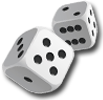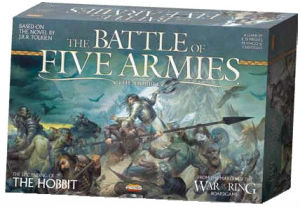



play board games
Board game reviews, strategy tips & session reports
Battle of Five Armies Board Game Review
 Stats:
Stats:
No. of players: 2
Amount of time to play: 120-180 min
Age requirements: 13+
Set-up time: about 10 minutes
The Battle of Five Armies simulates the huge fight at the end of the Hobbit. Will the shadow or free peoples win this epic struggle?
Battle of Five Armies Rules Description:
The Battle of Five Armies is the War of the Ring’s little sibling. It is not as epic or plays the exact same way, but it does share some aspects of this thematic classic.
The main timer for this game is the Fate Track. As the game goes along the free people’s player may add more characters to the game. If the Fate Track ever reaches 15 they win. Also if they bring out Beorn and the shadow player has less than six VPs the free people win. The shadow player wins if they have 10 VPs at the end a round.
Each round starts with both players drawing an event card and a story card. If you have more than six cards you must discard down to six.
The free people’s player activates up to three of their generals. This enables the general’s to use their special abilities. Then they must add that many leadership tokens to their armies on the board. These tokens let you re-roll misses in combat.
Next the shadow player must draw a tile (numbered 1-3) to advance the Fate Track. For each general activated the shadow player may draw another tile. The last tile they choose to draw advances the Fate Track and is discarded. The other tiles go back to the pool. If the tile has the fate symbol on it the free people player draws a Fate card and applies its effects.
The shadow must assign leadership tokens or place giant bats up to the number of dice they have. Giant bats can help shadow armies move or aid them in combat.
Both players roll all their dice. As in War of the Ring certain dice let you move or muster your armies, play event cards or move your characters. Players alternate using one die or you can pass if your opponent has more dice left than you.
Mustering in the Battle of Five Armies is not an exact science. Recruitment tokens are used and make mustering random. They are placed face down during set up and by other cards and special abilities. Mustering lets you flip tokens over and place the pictured unit in its place.
Combat uses a mix of cards and dice. Each unit has one (or more) favored terrain. The player with more units that share the defending space’s terrain as their favored terrain, gains terrain superiority. Terrain superiority lets you instantly draw an event card. Each player has a set of cards depicting each unit they could have in an army. In every round of combat you play one of these cards or an event card using its combat section. Once played unit cards cannot be played again in that combat unless you play the Regroup card. It lets you redraw all unit cards you have played back into your hand. Then the attacker rolls dice equal to their units’ combat strength and up to a maximum of five dice. They replace some of the white dice with black dice equal to the number of units on the card they played. Any fives or sixes hit and if any black dice hit it triggers that unit’s special ability. Next the defender rolls to hit following the same procedure.
One damage counter is added to an army for each hit. Once the number of damage counters is greater than the number of units in the army, you must remove a unit. Each unit you remove takes two damage tokens off the army. You continue to do this until the number of damage tokens is equal to or less than the number of units in the army.
After each round of combat the defender can retreat or the attacker can choose to stop attacking. If the defender retreats without playing their Regroup card, it is considered a rout. When you rout you must apply damage counters until you only have one or no damage tokens.
Some of the free people’s settlements have fortifications. Fortifications take damage tokens before a defending army does. And the attacker needs to roll sixes to hit until the fortification is broken.
After each player has used all their action dice you check the victory conditions. If no one has won you continue playing.
Quick Review of the Battle of Five Armies:
The Battle of Five Armies is a great follow up to War of the Ring. It is shorter but still very thematic and tense. The shadow player has military superiority but the more free people’s characters that are added to the board the smaller that advantage shrinks.
The components in this game are excellent. The miniatures look great and the art is fantastic. The damage counters are a bit fiddly and large to fit in the space. You must also be careful to make sure they stay with the correct army. The rules are a bit complicated but well written.
The theme of this game is great. As a Tolkien fan you can really enjoy this small part of the Hobbit played out as a board game. This is a board game that can tell a story. A lot of things make sense mechanically and the asymmetrical design makes both sides fun to play.
The combat is done well. It is nice that it is different from the War of the Ring. It is more detailed and might take a little longer but I enjoy the unit cards and the way special abilities are triggered. It actually makes you want to mix units in your armies so you always have unit cards to play.
If you enjoy War of the Ring but want something faster, pick this up. If you are looking for a fun, two-player war game, try this one. Overall I enjoy War of the Ring more but the Battle of Five Armies’ shorter playing time should make it easier to get to the table.
Score and synopsis: (Click here for an explanation of these review categories.)
Strategy 4 out of 6
Luck 5 out of 6
Player Interaction 6 out of 6
Replay Value 5 out of 6
Complexity 5 out of 6
Fun 5 out of 6
Overall 5 out of 6

Leave a Reply